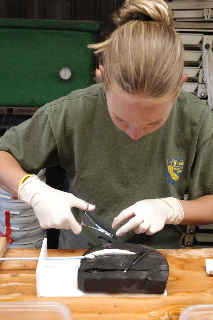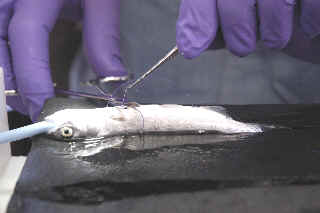Acoustic Tagging in San Joaquin River Seeks to Solve Salmon Mystery
 |
| The transmitter is the size of a pencil eraser. |
DFG Press Release
May 12, 2008. A new study is under way in the South Delta portion of the San Joaquin River system to figure out how to increase young salmon survival as they travel down stream to the ocean. Scientists are tracking tiny salmon called smolts in real time from sounds emitted by acoustic tags implanted inside them. The goal is to figure out what is killing the young salmon during their journey and solve those problems.
Some years up to 90 out of 100 of the young salmon called smolts died while migrating through the South Delta scientists estimate. Up to now, figuring out specifically where the main losses occur has been exceedingly difficult. This long term study will help solve these mysteries.
 |
Sara McCullock, DFG performs
fish surgery |
Tim Heyne Department of Fish and Game biologist said, "The results of this study and other evaluations being conducted in the San Joaquin River basin will determine the streamflows that are needed to overcome all the impediments to adequate salmon and steelhead production in this river system."
Tracking is done in river and South Delta waters with acoustic receiver buoys. Buoys have been anchored in key locations through out the river system and water diversion pathways to track the fish.
1,000 smolts are being implanted with the transmitters at the Merced Hatchery by DFG personnel and private consultants as part of the Vernalis Adaptive Management Plan in the San Joaquin River Agreement. The transmitters are being programmed by the United States Geological Service. The United State Fish and Wildlife Service is providing technical expertise along with two private consultant firms.
The young salmon were reared at the Merced Hatchery. Eggs spawned and reared at the hatchery each fall will produce the fish for this study over the next four years.
 |
| A smolt on the operating table |
Releases of smolts carrying the transmitters began the last week in April. All of the fish will be released prior to May 15.
The Vernalis Adaptive Management Plan is a multi-agency program aimed at better understanding the relationship between South Delta inflow, Delta exports, and juvenile salmon survival.
Learn more about the San Joaquin River Agreement and the Vernalis Adaptive Management Plan at www.sjrg.org.